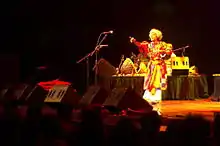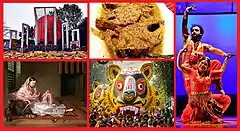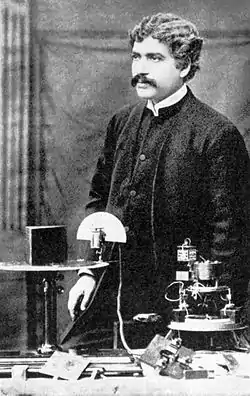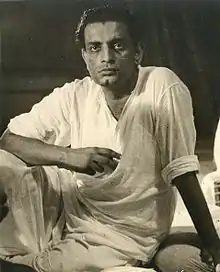Bengali science fiction
Bengali science fiction (Bengali: বাংলা বিজ্ঞান কল্পকাহিনী) is a part of Bengali literature containing science fiction elements.
| Bengali literature বাংলা সাহিত্য | |
|---|---|
 | |
| Bengali literature | |
| By category Bengali language | |
| Bengali language authors | |
| Chronological list – Alphabetic List | |
| Bengali writers | |
| Writers – Novelists – Poets | |
| Forms | |
| Novel – Poetry – Science Fiction | |
| Institutions and awards | |
| Literary Institutions Literary Prizes | |
| Related Portals Literature Portal India Portal | |
| Part of a series on the |
| Culture of Bengal |
|---|
 |
| History |
| Cuisine |
|
|
| Part of a series on |
| Bengalis |
|---|
 |
Earliest writers

Science fiction in the Bengali language is known as "kalpabigyan" .[1]
Bengali writers wrote various science fiction works in the 19th and early 20th centuries during the British Raj, before the partition of India. Isaac Asimov's assertion that "true science fiction could not really exist until people understood the rationalism of science and began to use it with respect in their stories" is true for the earliest science fiction written in the Bengali language.
The earliest notable Bengali science fiction was Jagadananda Roy's Shukra Bhraman (Travels to Venus). This story is of particular interest to literary historians, as it described a journey to another planet; its description of the alien creatures that are seen in Uranus used an evolutionary theory similar to the origins of man: "They resembled our apes to a large extent. Their bodies were covered with dense black fur. Their heads were larger in comparison with their bodies, limbs sported long nails and they were completely naked." This story was published a decade before H. G. Wells's The War of the Worlds (1898) in which Wells describes the aliens from Mars.
Some specialists credit Hemlal Dutta as one of the earliest Bengali science fiction writers for his Rohosso (The Mystery). This story was published in two installments in 1882 in the pictorial magazine Bigyan Dorpon (Mirror of Science).
In 1896, Jagadish Chandra Bose, considered to be the father of Bengali science fiction, wrote Niruddesher Kahini. This tale of weather control, one of the first Bengali science fiction works, features getting rid of a cyclone using a little bottle of hair oil (Kuntol Keshori). Later, he included the story with changes in the collection of essays titled Abyakto (1921) as Palatak Tufan (Runaway Cyclone). Both versions of the story have been translated into English by Bodhisattva Chattopadhyay.[2]
Roquia Sakhawat Hussain (Begum Rokeya), an early Islamic feminist, wrote Sultana's Dream, one of the earliest examples of feminist science fiction in any language. It depicts a feminist utopia of role reversal, in which men are locked away in seclusion, in a manner corresponding to the traditional Muslim practice of purdah for women. The short story, written in English, was first published in the Madras-based Indian Ladies Magazine in 1905, and three years later appeared as a book.
Premendra Mitra wrote the first novel, Kuhoker Deshe (In the Land of Mystery). Hemendra Kumar Ray wrote Meghduter Morte Agomon.[1]
Science fiction in Bangladesh
After Qazi Abdul Halim's Mohasunner Kanna (Tears of the Cosmos) was the first modern East Bengali science fiction novel. After independence Humayun Ahmed wrote the Bengali science fiction novel, Tomader Jonno Valobasa (Love For You All). It was published in 1973. This book is treated as the first full-fledged Bangladeshi science fiction novel. He also wrote Tara Tinjon (They were Three), Irina, Anonto Nakshatra Bithi (Endless Galaxy), Fiha Somikoron (Fiha Equation), and other works.
.jpg.webp)
Bengali science fiction is considered to have reached a new level of literary sophistication with the contributions of Muhammed Zafar Iqbal. Iqbal wrote a story named Copotronic Sukh Dukho when he was a student of Dhaka University. This story was later included in a compilation of Iqbal's work in a book by the same name. Muktodhara, a famous publishing house of Dhaka was the publisher of this book. This collection of science fiction stories gained huge popularity and the new trend of science fiction emerged among Bengali writers and readers. After his first collection, Mr. Iqbal transformed his own science fiction cartoon strip Mohakashe Mohatrash (Terror in the Cosmos) into a novel. All told, Muhammed Zafar Iqbal has written the greatest number of science fiction works in Bengali science fiction.
Following in the footsteps of the ancestors, more and more writers, especially young writers, started writing science fiction, and a new era of writing started in the writing of Bengali literature.
In 1997, Moulik, the first and longest-running Bangladeshi science fiction magazine, was first published, with famous cartoonist Ahsan Habib as the editor. This monthly magazine played an important role in the development of Bengali science fiction in Bangladesh. A number of new and very promising science fiction writers including Rabiul Hasan Avi, Anik Khan, Asrar Masud, Sajjad Kabir, Russel Ahmed, and Mizanur Rahman Kallol came of age while working with the magazine. Recently Nasim Sahnic is a promising young science fiction writer in Bangladesh. His latest science fiction books like Genetic code, Robopsychologist, Sundarbone Truti, Coxsbazarer Cossop are very famous to young generation.
Other writers of Bangladesh
Other notable writers in the genre include: Vobdesh Ray, Rakib Hasan, Nipun Alam, Ali Imam, Qazi Anwar Hussain, Altamas Pasha,is a Science fiction writer, his recent book is Valcaner Shopno published by Utthan porbo, Abdul Ahad, Anirudha Alam, Ahsanul Habib, Kamal Arsalan, Dr. Ahmed Mujibar Rahman, Moinul Ahsan Saber, Swapan Kumar Gayen, Mohammad Zaidul Alam, Mostafa Tanim, Muhammad Anwarul Hoque Khan, Jubaida Gulshan Ara Hena, Amirul Islam, Touhidur Rahman, Zakaria Swapan, Qazi Shahnur Hussain and Milton Hossain. Mr. Khan loves to write science fiction on parallel world and mystery of science or mathematics.
Writers from West Bengal

A number of writers from West Bengal, India have written science fiction. Credit for the first Bengali science fiction story is often given to later Bengali authors such as Jagadananda Roy, Hemlal Dutta and the polymath Jagadish Chandra Bose. Eminent film maker and writer Satyajit Ray also enriched Bengali science fiction by writing many short stories as well as science fiction series, Professor Shonku.Professor Shonku is a fictional scientist created by Satyajit Ray in a series of Bengali science fiction books. His full name is Trilokeshwar Shonku, and by occupation, he is an inventor. A short story known as The Alien written by Satyajit Ray about an alien named "Mr. Ang" gained popularity among Bengalis in the early 1960s. Ray is attributed with virtually pioneering the genre of Indian Science Fiction. It is alleged that the script for Steven Spielberg's film E.T. was based on a script for The Alien that Ray had sent to the film's producers in the late 1960s.[3]
Adrish Bardhan is one of the most notable names among West Bengal's sci-fi writers. Under the pen name of Akash Sen, Bardhan was also the editor of Ashchorjo, the first Bengali science fiction magazine. After a six-year run, this magazine ceased publishing. Later, Mr. Bardhan became editor of the magazine Fantastic, but it did not last long. Another Sci-Fi magazine, Vismoy Science Fiction, was edited by Sujit Dhar and Ranen Ghosh but was only published for two years.
Other notable science fiction writers of West Bengal include: Hemendra Kumar Roy, Sukumar Ray, Leela Majumdar, Premendra Mitra, Sunil Ganguly, Shirshendu Mukhopadhyay, Syed Mustafa Siraj, Samarjit Kar, Anish Deb, Biswajit Ganguly, Siddhartha Ghosh, Suman Sen (Sarpa Manav: Nagmoni Rohosyo, Ajana Sima: The X Boundary),[4] Rajesh Basu and Abhijnan Roychowdhury.
Science fiction magazines
Since 2014, in interest in Science Fiction has revived in West Bengal. While popular magazines for young readers, such as Shuktara, Kishore Bharati, Anandamela, among others, have published special issues dedicated to Science Fiction, a new breed of platforms promoting science fiction in Bengali through online web-magazines have emerged. Popular web-magazines like https://joydhakweb.com have published a number of good science fiction stories, in 2016, a significant development has occurred with the publication of Kalpabiswa (কল্পবিশ্ব) (www.kalpabiswa.com), first ever Science Fiction and Fantasy themed Bengali web-magazine for adult readers.
Portrayal of characters
Most Bengali science fiction authors use different characters for different stories, building them up in different forms according to the theme of the story. The stories by Muhammed Zafar Iqbal sometimes repeat names but have never used the same character in more than one story.
Qazi Shahnur Hussain, the eldest son of Qazi Anwar Hussain and grandson of Qazi Motahar Hussain, wrote a science fiction series named Chotomama Series. These are the adventures of a young Bangladeshi scientist Rumi Chotomama and his nephew.
Satyajit Ray wrote most of his science fiction works with the participation of the fictional character Professor Shanku or Trilokeshwar Shanku. Shanku is portrayed as an aged man with proficiency in 72 different languages who has created a number of innovative inventions. In Shanku's stories, he was regularly accompanied by other characters including scientists Jeremy Saunders and Wilhelm Krol, his neighbour Mr. Abinash, his servant Prahlad and his beloved cat, Newton.
Premendra Mitra created an immensely popular fictional character GhanaDa,a teller of tall tales having a scientific basis. In an interview to the magazine SPAN in 1974, Mitra said that he tried to keep the stories "as factually correct and as authentic as possible."
In the monthly magazine "SPAN"(July,1974), A K Ganguly writes "His (Premendra Mitra) novel "Manu Dwadash" (The Twelfth Manu) projects man into the far distant future - after the world has almost been destroyed by nuclear holocausts. Only three small tribes still exist. Even these face extinction for they have lost virtually all their procreative power from radiation. Children are no longer being born. The author deals superbly with the scientific and philosophical issues posed by this apocalyptic situation."
Mitra remarks "If Huxley's "Brave New World" can be regarded as science fiction__and it is indeed science fiction par excellence__my "Manu Dwadash" can advance some claim to this title."
References
- "Culture : Bengal : SFE : Science Fiction Encyclopedia". sf-encyclopedia.com.
- "Runaway Cyclone". Archived from the original on 5 September 2014. Retrieved 5 September 2014.
- "Manas: Culture, Indian Cinema- Satyajit Ray". ucla.edu.
- Suman Sen (2017), Sarpa Manav (Sarpa Manav: Nagmoni Rohosyo ed.), Kolkata: Diganto Publication, OL 26412550M
Bibliography
- Science Fiction: Ek Osadharan Jagat.
- Preface of Science Fiction Collection edited by Ali Imam and Anirudho Alam.
- Some different issues of Rohosso Potrika
External links
- Bengal at the Encyclopedia of Science Fiction
- Article on Bangla Science Fiction in Science Fiction Studies by Bodhisattva Chattopadhyay
- Article on the emergence of Science Fiction in India by Atanu Bhattacharya and Preet Hiradhar
- Joydhak Web-Magazine
- Kalpabiswa Web-Magazine